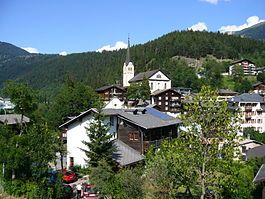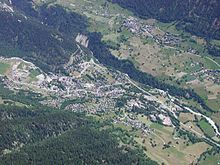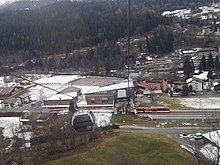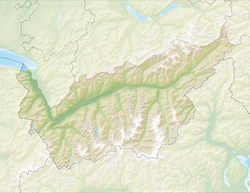Fiesch
Fiesch | |
|---|---|
 | |
| Coordinates: 46°24′N 8°8′E / 46.400°N 8.133°E | |
| Country | Switzerland |
| Canton | Valais |
| District | Goms |
| Government | |
| • Mayor | Russi Klaus |
| Area | |
• Total | 11.26 km2 (4.35 sq mi) |
| Elevation | 1,049 m (3,442 ft) |
| Population (31 December 2018)[2] | |
• Total | 921 |
| • Density | 82/km2 (210/sq mi) |
| Time zone | UTC+01:00 (Central European Time) |
| • Summer (DST) | UTC+02:00 (Central European Summer Time) |
| Postal code(s) | 3984 |
| SFOS number | 6057 |
| ISO 3166 code | CH-VS |
| Surrounded by | Bellwald, Betten, Ernen, Fieschertal, Lax |
| Website | www SFSO statistics |
Fiesch is a municipality in the district of Goms in the canton of Valais in Switzerland. Nearby Fiescheralp is administered by Fiesch and is accessible by the Eggishorn lift.
It has been designated a UNESCO World Heritage site for its view of the Jungfrau-Aletsch Protected Area.
History
[edit]Fiesch is first mentioned in 1203 as "Vios". In 1438 it is recorded as "Viesch", and has been known as Fiesch since 1905.[3]

The Fiesch derailment occurred in 2010.
Geography
[edit]
Fiesch has an area, as of 2011[update], of 11.3 square kilometers (4.4 sq mi). Of this area, 32.6% is used for agricultural purposes, while 40.6% is forested. Of the rest of the land, 6.4% is settled (buildings or roads) and 20.4% is unproductive land.[4]
The municipality is located in a small valley and on the slopes above both sides of the Weisswasser.
Coat of arms
[edit]The blazon of the municipal coat of arms is Azure, a fess wavy Argent in base Coupeaux of the same.[5]
Demographics
[edit]
Fiesch has a population (as of December 2020[update]) of 909.[6] As of 2008[update], 17.9% of the population are resident foreign nationals.[7] Over the last 10 years (1999–2009 ) the population has changed at a rate of -4.5%. It has changed at a rate of -2% due to migration and at a rate of -2% due to births and deaths.[4]
Most of the population (as of 2000[update]) speaks German (872 or 87.6%) as their first language, Serbo-Croatian is the second most common (87 or 8.7%) and Albanian is the third (13 or 1.3%). There are 7 people who speak French, 1 person who speaks Italian.[8]
As of 2008[update], the gender distribution of the population was 50.9% male and 49.1% female. The population was made up of 403 Swiss men (41.5% of the population) and 92 (9.5%) non-Swiss men. There were 382 Swiss women (39.3%) and 95 (9.8%) non-Swiss women.[9] Of the population in the municipality 433 or about 43.5% were born in Fiesch and lived there in 2000. There were 272 or 27.3% who were born in the same canton, while 103 or 10.3% were born somewhere else in Switzerland, and 172 or 17.3% were born outside of Switzerland.[8]
The age distribution of the population (as of 2000[update]) is children and teenagers (0–19 years old) make up 24.1% of the population, while adults (20–64 years old) make up 60% and seniors (over 64 years old) make up 15.9%.[4]
As of 2000[update], there were 401 people who were single and never married in the municipality. There were 514 married individuals, 57 widows or widowers and 24 individuals who are divorced.[8]
As of 2000[update], there were 372 private households in the municipality, and an average of 2.5 persons per household.[4] There were 97 households that consist of only one person and 35 households with five or more people. Out of a total of 379 households that answered this question, 25.6% were households made up of just one person and there were 2 adults who lived with their parents. Of the rest of the households, there are 110 married couples without children, 145 married couples with children There were 11 single parents with a child or children. There were 7 households that were made up of unrelated people and 7 households that were made up of some sort of institution or another collective housing.[8]
In 2000[update] there were 266 single family homes (or 54.8% of the total) out of a total of 485 inhabited buildings. There were 151 multi-family buildings (31.1%), along with 29 multi-purpose buildings that were mostly used for housing (6.0%) and 39 other use buildings (commercial or industrial) that also had some housing (8.0%).[10]
In 2000[update], a total of 351 apartments (41.8% of the total) were permanently occupied, while 427 apartments (50.8%) were seasonally occupied and 62 apartments (7.4%) were empty.[10] As of 2009[update], the construction rate of new housing units was 4.1 new units per 1000 residents.[4] The vacancy rate for the municipality, in 2010[update], was 1.02%.[4]
The historical population is given in the following chart:[3][11]

Twin Town
[edit]Fiesch is twinned with the town of Neufra, Germany.[12]
Politics
[edit]In the 2007 federal election the most popular party was the CVP which received 60.07% of the vote. The next three most popular parties were the SVP (16.05%), the SP (14.91%) and the FDP (7.37%). In the federal election, a total of 356 votes were cast, and the voter turnout was 50.6%.[13]
In the 2009 Conseil d'État/Staatsrat election a total of 352 votes were cast, of which 18 or about 5.1% were invalid. The voter participation was 51.4%, which is similar to the cantonal average of 54.67%.[14] In the 2007 Swiss Council of States election a total of 356 votes were cast, of which 7 or about 2.0% were invalid. The voter participation was 51.4%, which is much less than the cantonal average of 59.88%.[15]
Economy
[edit]The main source of income of the village is tourism, especially hiking, mountain biking, paragliding, snowboarding and skiing, along with many other sports for which the village is an ideal starting point. Above Fiesch, in the Fiescheralp (previously referred to as Kühboden), there is a ski resort and a launch point for hang glider and paraglider pilots.
As of 2010[update], Fiesch had an unemployment rate of 2.4%. As of 2008[update], there were 10 people employed in the primary economic sector and about 7 businesses involved in this sector. 57 people were employed in the secondary sector and there were 14 businesses in this sector. 551 people were employed in the tertiary sector, with 78 businesses in this sector.[4] There were 532 residents of the municipality who were employed in some capacity, of which females made up 41.9% of the workforce.
In 2008[update] the total number of full-time equivalent jobs was 511. The number of jobs in the primary sector was 5, all of which were in agriculture. The number of jobs in the secondary sector was 54 of which 23 or (42.6%) were in manufacturing and 31 (57.4%) were in construction. The number of jobs in the tertiary sector was 452. In the tertiary sector; 84 or 18.6% were in wholesale or retail sales or the repair of motor vehicles, 55 or 12.2% were in the movement and storage of goods, 119 or 26.3% were in a hotel or restaurant, 1 was in the information industry, 18 or 4.0% were the insurance or financial industry, 9 or 2.0% were technical professionals or scientists, 4 or 0.9% were in education and 80 or 17.7% were in health care.[16]
In 2000[update], there were 285 workers who commuted into the municipality and 183 workers who commuted away. The municipality is a net importer of workers, with about 1.6 workers entering the municipality for every one leaving.[17] Of the working population, 10.2% used public transportation to get to work, and 39.1% used a private car.[4]
Religion
[edit]
From the 2000 census[update], 804 or 80.7% were Roman Catholic, while 60 or 6.0% belonged to the Swiss Reformed Church. Of the rest of the population, there were 80 members of an Orthodox church (or about 8.03% of the population), and there was 1 individual who belongs to another Christian church. There were 14 (or about 1.41% of the population) who were Islamic. 24 (or about 2.41% of the population) belonged to no church, are agnostic or atheist, and 13 individuals (or about 1.31% of the population) did not answer the question.[8]
Education
[edit]In Fiesch about 370 or (37.1%) of the population have completed non-mandatory upper secondary education, and 90 or (9.0%) have completed additional higher education (either university or a Fachhochschule). Of the 90 who completed tertiary schooling, 67.8% were Swiss men, 15.6% were Swiss women, 8.9% were non-Swiss men and 7.8% were non-Swiss women.[8]
During the 2010-2011 school year there were a total of 179 students in the Fiesch school system. The education system in the Canton of Valais allows young children to attend one year of non-obligatory Kindergarten.[18] During that school year, there 2 kindergarten classes (KG1 or KG2) and 31 kindergarten students. The canton's school system requires students to attend six years of primary school. In Fiesch there were a total of 6 classes and 98 students in the primary school. The secondary school program consists of three lower, obligatory years of schooling (orientation classes), followed by three to five years of optional, advanced schools. There were 81 lower secondary students who attended school in Fiesch.[19] All the upper secondary students attended school in another municipality.
As of 2000[update], there were 122 students in Fiesch who came from another municipality, while 31 residents attended schools outside the municipality.[17]
Fiesch is home to the Regionalbibliothek Goms in Fiesch library. The library has (as of 2008[update]) 3,843 books or other media, and loaned out 3,885 items in the same year. It was open a total of 150 days with average of 6 hours per week during that year.[20]
Transport connections
[edit]

Fiesch is served by the following transport connections:
- Furka Pass- the road through the Rhone Valley between Brig and Gletsch;
- Fiesch railway station on the Matterhorn Gotthard Bahn (formerly the Furka Oberalp Bahn);
- The valley station of the Fiesch-Eggishorn cable car;
- Postauto buses linking Fiesch with Fieschertal and Ernen.
Lifts
[edit]
From the village one cable car brings you to Fiescheralp. This new cable car starts directly at the train station and has been opened in 2019.
The main lifts are:[21]
| Name | type | elevation (ground station) |
elevation (mountain station) |
slope length | capacity (persons/hour) |
construction year |
|---|---|---|---|---|---|---|
| Fiesch- -alp 1+2 (removed) | cable car | 1074 | 2227 | 2940 | 800 | 1973 |
| Fiesch- -alp 3+4 (removed) | cable car | 1071 | 2221 | 2937 | 270 | 1966 |
| Fiescheralp-Eggishorn | cable car | 2225 | 2879 | 1836 | 495 | 1968 |
| Heimat | chairlift | 1858 | 2301 | 1144 | 1400 | 2000 |
| Talegga | chairlift | 2208 | 2727 | 1782 | 2200 | 2010 |
| Flesch | chairlift | 2208 | 2630 | 1357 | 2400 | 1993 |
| Trainer 1 | surface lift | 2206 | 2264 | 218 | 1200 | 1987 |
| Trainer 2 | surface lift | 2206 | 2264 | 218 | 1200 | 1987 |
| Laxeralp 1 | surface lift | 2135 | 2179 | 396 | 1100 | 1981 |
| Laxeralp 2 | surface lift | 2179 | 2280 | 394 | 1214 | 1981 |
References
[edit]- ^ a b "Arealstatistik Standard - Gemeinden nach 4 Hauptbereichen". Federal Statistical Office. Retrieved 13 January 2019.
- ^ "Ständige Wohnbevölkerung nach Staatsangehörigkeitskategorie Geschlecht und Gemeinde; Provisorische Jahresergebnisse; 2018". Federal Statistical Office. 9 April 2019. Retrieved 11 April 2019.
- ^ a b Fiesch in German, French and Italian in the online Historical Dictionary of Switzerland.
- ^ a b c d e f g h Swiss Federal Statistical Office Archived 5 January 2016 at the Wayback Machine Retrieved 7 September 2011
- ^ Flags of the World.com. Retrieved 7 September 2011
- ^ "Ständige und nichtständige Wohnbevölkerung nach institutionellen Gliederungen, Geburtsort und Staatsangehörigkeit". bfs.admin.ch (in German). Swiss Federal Statistical Office - STAT-TAB. 31 December 2020. Retrieved 21 September 2021.
- ^ Swiss Federal Statistical Office - Superweb database - Gemeinde Statistics 1981-2008 Archived 28 June 2010 at the Wayback Machine (in German) Retrieved 19 June 2010
- ^ a b c d e f STAT-TAB Datenwürfel für Thema 40.3 - 2000 Archived 9 August 2013 at the Wayback Machine (in German) Retrieved 2 February 2011
- ^ Ständige Wohnbevolkerung nach Geschlecht und Heimat am 31.12.2009.xls (in German and French) Retrieved 24 August 2011
- ^ a b Swiss Federal Statistical Office STAT-TAB - Datenwürfel für Thema 09.2 - Gebäude und Wohnungen Archived 7 September 2014 at the Wayback Machine (in German) Retrieved 28 January 2011
- ^ Swiss Federal Statistical Office STAT-TAB Bevölkerungsentwicklung nach Region, 1850-2000 Archived 30 September 2014 at the Wayback Machine (in German) Retrieved 29 January 2011
- ^ Conseil des Communes et Regions d'Europe (in French) Retrieved 27 April 2011
- ^ Swiss Federal Statistical Office, Nationalratswahlen 2007: Stärke der Parteien und Wahlbeteiligung, nach Gemeinden/Bezirk/Canton Archived 14 May 2015 at the Wayback Machine (in German) Retrieved 28 May 2010
- ^ Staatsratswahlen vom 1. März 2009 (in German) Retrieved 24 August 2011
- ^ Ständeratswahl 2007 (in German) Retrieved 24 August 2011
- ^ Swiss Federal Statistical Office STAT-TAB Betriebszählung: Arbeitsstätten nach Gemeinde und NOGA 2008 (Abschnitte), Sektoren 1-3 Archived 25 December 2014 at the Wayback Machine (in German) Retrieved 28 January 2011
- ^ a b Swiss Federal Statistical Office - Statweb (in German) Retrieved 24 June 2010
- ^ EDK/CDIP/IDES (2010). Kantonale Schulstrukturen in der Schweiz und im Fürstentum Liechtenstein / Structures Scolaires Cantonales en Suisse et Dans la Principauté du Liechtenstein (PDF) (Report). Retrieved 24 June 2010.
- ^ Obligatorische Schulzeit (in German) Retrieved 24 August 2011
- ^ Swiss Federal Statistical Office, list of libraries Archived 6 July 2015 at the Wayback Machine (in German) Retrieved 14 May 2010
- ^ Interactive map of the Aletschgebiet Archived 16 December 2008 at the Wayback Machine. Viewed 16 December 2008
External links and references
[edit]- Municipal website (in German)
- Tourism website (in English)
- Fiesch-Eggishorn cable car website Archived 7 June 2015 at the Wayback Machine (in English)
- Fiesch in German, French and Italian in the online Historical Dictionary of Switzerland.




